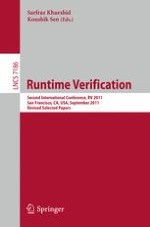This book constitutes the thoroughly refereed post-conference proceedings of the Second International Conference on Runtime Verification, RV 2011, held in San Francisco, USA, in September 2011. The 24 revised full papers presented together with 3 invited papers, 4 tutorials and 4 tool demonstrations were carefully reviewed and selected from 71 submissions. The papers are organized in topical sections on parallelism and deadlocks, malware detection, temporal constraints and concurrency bugs, sampling and specification conformance, real-time, software and hardware systems, memory transactions, tools; foundational techniques and multi-valued approaches.
